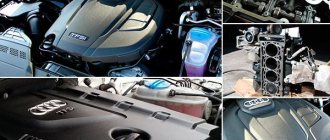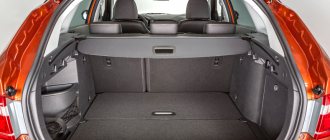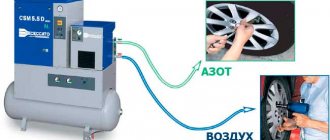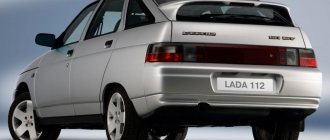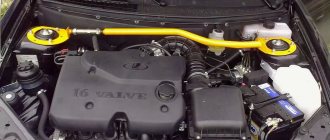What kind of car drive systems exist?
The classical classification implies the existence of three types of drive for a machine. These are front, back and full. But within these types, several more subspecies can be distinguished, which are sometimes worth knowing about when choosing a car. Everything is clear with the front and rear drive options, but the full one raises certain questions, and it is with it that the most difficulties arise when selecting.
So, here are the generally accepted designations for different types of drives:
- FWD (Forward Wheel Drive). This is a traditional front-wheel drive; more than 70% of cars today have exactly this option for transmitting torque to the wheels. The design is classic; in most cases, no subtypes or additional parameters can be distinguished here.
- RWD (Rear Wheel Drive). Under this designation lies traditional rear-wheel drive. The only difference in this torque transmission option is the location of the engine, which determines the design of the transmission. In 99% of cases, the engine is installed in the front, and the torque is transmitted through the driveshaft. But there is also a rear engine location.
- 4WD (Four Wheel Drive). This is a classic all-wheel drive, which can be permanent or plug-in. Previously, these types of technologies could be easily recognized by two levers in the central tunnel. The main difference is the mechanical differential lock, so that it is possible to transmit torque equally to all wheels at once.
- AWD (All Wheel Drive). This is a modern, adapted version of all-wheel drive, where the electronics decide which wheels to connect to the engine at a particular moment in time. Complex electronics and rather poor efficiency were disadvantages of the first AWD cars, but today everything is actively changing.
The last two types of all-wheel drive can also be divided into two more groups. The first will include cars with main rear-wheel drive and a front axle connection. And the second group will initially include front-wheel drive cars with a plug-in rear axle.
Pros and cons of AWD
Strengths of the technology:
- relative simplicity and low cost of design;
- fully autonomous control;
- the driver does not require special knowledge and skills;
- high fuel efficiency;
- programs work great on soil, sand, snow;
- the computer can predict problems in movement;
- much higher accuracy and speed of reaction to the situation;
- more gentle loads on the engine and transmission.
Weaknesses of All-wheel drive:
- no downshifts or differential locks;
- the program may make errors and inappropriate actions;
- the driver, as a rule, cannot influence the behavior of AWD in any way;
- the transmission, in most cases, is less reliable compared to 4WD;
- on the highway the car loses all the benefits of all-wheel drive;
- more limited capacity to transport goods;
- lower ground clearance and ground clearance compared to 4WD.
Thus, the choice between cars with 4WD and AWD directly depends on the conditions in which you plan to use the car. If you want an everyday car that you can use occasionally to get out into nature, then AWD is the perfect option. Well, for hunting or fishing trips into the depths of the wild, or for transporting goods along the remains of destroyed roads, only heavy SUVs or pickups with permanent all-wheel drive and a set of off-road options are suitable.
All-wheel drive: design and operation
The most widespread is the all-wheel drive transmission with viscous coupling. It consists of a manual transmission or automatic transmission, clutch, transfer case, cardan and final drives, cross-wheel and center differentials.
This all-wheel drive option is used on cars with front- and rear-wheel drive configurations. In the first case, the gearbox is installed across the axis of the car, in the second - along. This affects the design features of the transfer case and cardans.
The clutch on a manual transmission performs two functions:
- protects the transmission from overloads;
- provides short-term separation of the engine and gearbox during gear changes.
Automatic transmissions are equipped with a torque converter that performs a similar function.
The transfer case, which includes a reduction gearbox and a center differential, distributes torque between the axles and increases it when the “low gear” is engaged.
To improve off-road performance, the transmission is equipped with a center differential lock. In the simplest case, it is automatically blocked by a viscous coupling. More advanced models use a multi-plate friction clutch and a Torsen limited-slip differential.
On vehicles designed for off-road driving, automatic or manual differential locking between the wheels is installed.
The system works as follows:
- torque from the engine is transmitted through the clutch to the gearbox;
- engine power is distributed among the axles through the transfer case;
- cardan drives drive the cross-axle differentials of the rear and front axles.
Part-time 4WD: hard-wired all-wheel drive
“Part-time” is the simplest and most advanced system of forced all-wheel drive, traditional for SUVs since the time of the military Jeep Willys. Due to its utilitarian nature, it is becoming less and less common on modern cars. The exception is the Suzuki Jimny, which even in the new 2022 generation remains with the same hard 4WD as all previous Jimny cars. Also, part-time is used by all UAZs (including Patriot), Toyota Land Cruiser 70 (Hunter), Fortuner and FJ Cruiser; Jeep Wrangler and many pickups: Toyota Hilux, Tacoma and Tundra; Nissan Navara and NP300, Mazda BT-50. More often, “part time” is found on older models: Suzuki Escudo/Grand Vitara (before 2005), Nissan Safari/Patrol (before 2010) and others.
The part-time scheme is called rigid, because when 4WD is turned on, the front and rear axles of the car are connected directly, without a differential. The best video about the design of the differential and its role in the car was shot at General Motors back in 1937. It is so clear that it does not require translation. Enjoy the pre-war absence of computer graphics:
The differential allows the wheels of the drive axle to rotate at different speeds, which is necessary when turning. If the car is all-wheel drive and has two driving axles, then a differential is also needed between them. As already mentioned, in the rigid part-time scheme there is no center differential , which imposes restrictions on such an all-wheel drive: it cannot be used on asphalt . “Part-time” is designed for temporary connection: on the ground, in mud, in sand, in snow, on ice - anywhere where the wheels can slip a little when turning, compensating for the lack of a differential. When returning to clean asphalt, all-wheel drive must be turned off. By the way, not all owners of the same Jimniks know about this, driving all winter with 4WD turned on. Consequences: increased tire wear and load on transmission components, as well as poor handling - the car does not really want to corner. But driving with rear-wheel drive in winter is fraught with skidding, because a slippery area can arise unexpectedly. Therefore, the part-time scheme is not very convenient in urban environments and at high speeds.
Connectable (part time)
Under normal conditions, the motor energy is transmitted to one axle (rear or front). If necessary, all-wheel drive is activated using a special lever or button. This is the simplest and cheapest type of four wheel drive used for off-road driving. This transmission usually does not have a differential that distributes torque between the axles. Therefore, it cannot be constantly used on the highway. Otherwise, fuel consumption increases and tire and transmission wear accelerates.
On hard surfaces, you need to disable all-wheel drive. It should only be used in mud, sand, ice or snow. Its disadvantage is that the lack of a differential between the axles worsens the car's handling on ice and wet asphalt.
Four-wheel drive with clutch
Pros:
- low cost and simplicity of the device;
- low weight;
- possibility of fine-tuning the system.
Minuses:
- poor reliability and resistance to overloads;
- instability of characteristics.
A rigid differential lock is not bad off-road, but how can you force the all-wheel drive system to dose the torque dynamically? The degree of slippage is always different... The solution was found in the mid-50s.
Active Torque Split AWD system for Mazda CX-7 with multi-plate clutch instead of center differential
The conventional mechanical differential was supplemented with a viscous coupling (viscous coupling). A viscous coupling is a part in which rows of blades connected to the input and output shafts rotate in a special fluid. The input and output shafts rotate freely relative to each other, but the secret of the coupling is in the filler, which increases its viscosity as the temperature rises.
AWD or monowheel drive
AWD is a new type of layout (mono-wheel drive), which has gradually conquered the automotive market. It is used on many modern sedans, SUVs, crossovers: Audi S4, Renault Duster, Subaru Forester, Hyundai Greta. Models with such a system drive in a standard situation on one drive, but when there is not enough traction, the second axle is automatically connected.
Although vehicles with All Whell Drive are considered off-road, they are not actually off-road. All four wheels here do not rotate constantly, but from time to time. The usual percentage of effort on the axles is 60/40 in favor of the front. For Subaru, Audi and the like, the distribution is carried out in a 50/50 ratio.
There are two types of AWD:
- constant (the drive is automatically supplied to both axles, which provides an advantage on ice, snow and mud);
- connectable (rotation is sent to only one axle, depending on the model it can be the front or rear axle).
Full-time 4WD: permanent all-wheel drive
In the full-time scheme, there is no way to disable 4WD: the drive wheels are always connected to the engine, and for normal driving on asphalt, a third - central - differential is installed between the axles. This type of drive is called “full time”, permanent full. Many cars are equipped with it: Toyota Land Cruiser 80/100/200, Land Cruiser Prado; Volkswagen Touareg; Land Rover Discovery, Defender; and of course, old Niva - since 1977! The list of cars with full-time 4WD is very large and even includes passenger cars and SUVs: Audi with the classic Quattro transmission, Toyota RAV4 of the first two generations, Mark II and Crown in four trim levels; Suzuki Escudo/Grand Vitara 3rd generation, Subaru models with VTD transmission and others. True, among new cars, honest “fulltime” is becoming less and less common.
Is the full-time scheme ideal? Of course no. The center differential of the classical design (“free” or “open”) has a significant inherent disadvantage: it directs traction along the path of least resistance. In practice, it looks like this: a car with a proud FULL-TIME 4WD nameplate gets stuck with just one wheel in deep sand or mud and cannot move - the wheel skids helplessly in the mud, while all the others stand still. 1WD! This is because the differentials (first the center differential, then the cross-axle differential) direct the torque to the wheel that is easiest to turn - that is, where the grip is the worst. To prevent such awkward situations from arising, a differential lock - a forced limitation of its tendency to rotate freely.
Center differential locking button
The methods for locking the central (center) differential differ from car to car. Serious SUVs have the option of forced 100% hard locking - in this mode, all-wheel drive actually turns into part-time, with all the limitations inherent in this scheme (cannot be used on asphalt). Passenger cars and SUVs usually do not have a hard lock - instead, the differential is automatically locked by a viscous, hydraulic or electromechanical clutch. Such solutions do not provide complete blocking, so even the old Ravchik is no match for the Prado off-road, although formally both have honest “full time”.
By the way, the distribution of torque between the front and rear axles in full-time 4WD is not always 50/50. For better handling, modern cars with permanent all-wheel drive use Torsen limited-slip differentials, which can shift up to 80% of the thrust to one (usually rear) axle, or achieve the same effect using electronic locking. This way the car becomes more predictable in turns, without losing any of the “honesty” of the all-wheel drive.
Pros and cons of part-time 4WD
✅ Simplicity and reliability.
✅ Ability to disable 4WD to save fuel.
⛔ Restrictions on use on hard surfaces.
⛔ Deterioration in handling in 4WD mode.
Pros and cons of full-time 4WD
✅ Simplicity and reliability.
✅ Ability to drive 4WD on any surface.
⛔ The need to lock the center differential.
⛔ Increased fuel consumption.
Full-time 4WD
In cars with this type of transmission, power is always transmitted to four wheels. They are separated using a center differential, which improves handling, reduces tire wear and reduces the load on the units. To improve cross-country ability, “Full-time 4WD” vehicles are equipped with differential locks (inter-wheel and inter-axle). This function is implemented in two versions: automatic or manual.
This type of vehicle is least susceptible to skidding and has the best cross-country ability. If there is a differential lock, it should only be engaged before overcoming mud, snow, sand or a long slippery climb. In other cases, this only worsens driving characteristics and reduces the service life of tires and components.
Multi-mode all-wheel drive (Selectable 4WD)
The best type of transmission, combining the advantages of all of the above. Its only drawback is its high price. A car with multi-mode all-wheel drive can drive with one or two drive axles. The driver himself chooses the state of the differentials. On asphalt, the front axle is sufficient; on slippery roads, you should engage permanent 4-wheel drive, and on off-road conditions, lock the differential (in the most difficult areas, all three are interaxle and interwheel).
Vehicles with front wheel drive FWD
The lack of additional components at the rear of the car means that a greater percentage of its weight falls on the front axle. This type of construction is characterized by higher resistance to side wind gusts and better traction on wet and snowy surfaces. However, driving on slippery surfaces becomes more difficult when the rear of the vehicle is loaded with a lot of luggage. This is especially noticeable when going uphill.
Because of the front axle's dual function of driving and turning, front-wheel drive is not suitable for high-power vehicles. During dynamic starts and accelerations, you can feel the steering wheel “tearing” to the sides.
Front-wheel drive is also not suitable for aggressive cornering - the wheels are not able to effectively transmit power and at the same time direct the car in the desired direction. We are talking about understeer, which is also affected by the weight distribution characteristics of the front-wheel drive.
Understeer is called camber extension. It manifests itself in the fact that the front wheels lose traction and, as a result, are unable to maintain the track set by the position of the steering wheel. This causes the car to drift off the curve.
Advantages, disadvantages and application of front-wheel drive. The FWD drive, due to its characteristics, is currently the most popular solution. It is used primarily in small city compact cars and mid-range sedans. Due to their limitations, the vast majority of them are small or medium power vehicles.
Advantages of FWD drive
- Compact luggage compartment and flat floor in the back row of seats;
- Less weight and simpler vehicle design, which leads to cheaper operation;
- Lower production costs for the vehicle, which is reflected in the purchase price.
Disadvantages of FWD drive
- Weight distribution can affect stability during acceleration and braking;
- Worse at high power than other drive types.
Exceptions to the rule
To be fair, it should be noted that the part time scheme is not a panacea for off-roading or a mandatory distinguishing feature of a professional SUV. Suffice it to recall the Mercedes-Benz G-Class, Land Rover Defender and in general the products of the brand from Solihull, Toyota Land Cruiser Prado and Land Cruiser 200, Mitsubishi Pajero and other serious “rogues” equipped with a permanent all-wheel drive system in which traction is provided to all four wheels distributes the center differential.
Automatic all-wheel drive (AWD)
So we get to the conditionally “dishonest” schemes of automatically connected all-wheel drive, which are becoming more popular every year. The principle of their operation is similar: in normal mode, the car remains conditionally single-wheel drive, and the second drive axle is actively engaged only when the first one slips. Of course, without any differentials - most often the traction is transmitted through a viscous or friction clutch.
Today there are a majority of cars with various variations of AWD: in fact, these are almost all all-wheel drive cars and crossovers. European manufacturers widely use the Haldex coupling in their 4WD systems, which has already gone back 5 generations. Asian automakers more often design something of their own: ATC/DTC for Toyota or Active AWD for Subaru (yes, not all Subarus are equipped with honest all-wheel drive).
It must be admitted that AWD systems are progressing, actively eliminating childhood diseases of past years, for which many motorists still do not like them. In advanced systems, the lag of the 4WD connections was reduced to nothing, constantly supplying 5–10% of traction to the rear wheels. Smart electronics itself selects the appropriate mode, optimally distributing torque between the axles. And turning off all-wheel drive when it's not needed significantly saves fuel.
Electronic emulation of differential locks copes well with diagonal hangings when you have to drive off the asphalt. But on serious off-road conditions there is nothing to do with AWD: slipping in mud or deep snow will lead to quick clutch failure and very expensive repairs. In fact, AWD systems are “asphalt” all-wheel drive, designed for comfortable use in the city and on the highway.
Automatic (Automatic 4WD)
Like the Part time system described above, this type of transmission is activated only when necessary. However, instead of the driver, this is done automatically. The connection is made using a viscous coupling or multi-plate clutch controlled electronically. The second axle comes into operation when the wheels of the main drive axle slip. The system provides good driving performance on sand, mud or unclean winter roads. However, it is poorly suited for off-road driving: the second axle is connected too late, when the first one has already stalled.
Read more about what AWD is
So, let's look at AWD technology, namely what it is in practice in a modern car, and get acquainted with the term “all-wheel drive.”
The idea behind this technology itself is ingenious:
- As you know, the drive system in each wheel is equipped with many sensors. Their task is to measure the angular velocity of rotation and other important parameters.
- All this information in the car is transmitted to the computer. It is deciphered there.
- The computer analyzes the resulting mass of data in accordance with its program. And depending on how each wheel behaves, it makes the optimal distribution of power and torque. And not only along the axles, but also separately along the wheels. Needless to say, what this means for the car, how convenient and important it is for it.
What are the differences between the different types of all-wheel drive technologies?
A logical question when purchasing modern crossovers and SUVs is what is the difference between AWD and 4WD. In fact, the differences are that in the 4WD system you yourself can control the processes of transmitting torque to the wheels, and in the crossover adapted version the electronics do everything for you. Fewer and fewer cars get the classic 4WD option, giving way to more expensive and technologically advanced systems.
As a rule, in cars with 4WD the front axle is disabled, and the rear axle is permanently connected to the transmission system. In AWD the opposite happens. Mechanical locking, adjustments and control capabilities of the drive system are an exclusive privilege of real 4WD jeeps.
Classic technology uses a transfer case, which has many functions, but in modern cars, all the work is done by an electronic control system with many automatic functions. As you can see, the difference between 4WD and AWD is quite significant.
Are there any clear advantages to AWD technologies?
To illustrate the key clear advantage of AWD technology over other similar drive formats in a car, let’s imagine driving on an ordinary domestic road, not ideal, but not broken into pieces. It is clear that for such a road there is no need to use front-wheel drive, since this will only lead to increased fuel consumption. You can completely get by with a drive on two front wheels: this will give not only savings, but also good controllability of the car.
But here is a completely different picture. So, you found yourself on a terrible dirt road, especially after the rain, and it turned into a continuous mess. If you use two driving wheels, you won’t go far, since there is a high probability of completely “dropping anchor” in some unnoticed hole full of slurry. Therefore, the AWD system automatically connects both rear wheels to work using the on-board computer. Part of the engine power is transferred to them. In other words, the car becomes all-wheel drive.
As for the difference with the 4WD format, with its help the power is distributed equally between the wheels and axles. In our case, the front axle practically receives the main load, taking up more than 60% and up to 90% of the power and torque. Only certain car brands (for example, Audi) distribute them equally, in a ratio of 50 to 50. If you buy a car, the last point must be taken into account.
Let's sum it up
When purchasing an all-wheel drive vehicle, you must separately take into account the conditions in which the car will be used, with what loads, etc. For maximum traction and power in complete off-road conditions, a 4WD all-wheel drive system with a transfer case will be the best solution. This transmission is perfect for towing or transporting heavy loads, overcoming difficult areas, etc. However, fuel consumption and maintenance costs for such a machine will be higher.
This transmission is structurally simpler and cheaper, but is not designed for extreme loads. In any case, the potential owner should take into account the nuances discussed above when choosing an AWD or 4WD drive.
Source
What are the disadvantages of the AWD drive system?
An important difference between the drive system under consideration and the 4WD system is also the absence of lower gears, and there is no practical possibility of locking differentials. This is not very convenient when driving off-road, causing fair criticism from many car professionals, since with the help of a lower gear it would be possible to significantly increase power, and blocking the differentials would prevent wheel slipping.
Therefore, another important piece of advice: if you have purchased a car equipped with an AWD system, always remember that the main role on the trip may well be played not by your driving skills, but by the quality of the program of the computer installed on board the car.
Pros and cons of auto-connected AWD
✅ Work in automatic mode without driver intervention.
✅ Automatic 4WD shutdown to save fuel.
⛔ Failures and overheating of couplings during active slipping.
⛔ Impossibility of use on serious off-road conditions.
How does AWD work?
A typical All-wheel drive operating scenario is as follows. Imagine that you are driving along a normal road, even with bumps and puddles, but still far from off-road. It is clear that in such conditions all-wheel drive is useless, because it causes increased fuel consumption. Front-wheel drive is quite sufficient - it is both economical and provides good handling.
It's a different story when you pull onto a dirt road, especially if it's recently rained and the dirt has turned to mud. On two driving wheels you can thoroughly “sit down” in some hole or puddle. Therefore, the AWD on-board computer automatically connects the rear wheels, transferring part of the engine power to them. The car becomes all-wheel drive. But here there are some differences from traditional all-wheel drive vehicles.
Traditional all-wheel drive technology, 4WD, typically distributes power equally between the axles and wheels. In the case of AWD, the front axle almost always gets the most power, accounting for 60 to 90 percent of the engine's power and torque. Only a few manufacturers like Audi and Subaru provide the usual equal (50/50) distribution between the axles.
Another difference from 4WD is the absence of low gears and the possibility of differential locks. Many off-road enthusiasts do not like this lack of “adult” options, and their indignation is well founded. After all, a lower gear significantly increases the power supplied to the wheels, and differential locks prevent wheel slipping. Without these functions, attacking serious off-road conditions is quite reckless.
When driving off a paved road in an AWD vehicle, remember that the success of your trip depends mainly not on your driving skills, but on the quality of the on-board computer program. Some manufacturers bring elements of traditional 4WD to All-wheel drive by providing manual control, but this is rare. In general, AWD is perfect for driving on light off-road conditions, but not in remote, deep swamps.
The difference between 4WD and AWD
Generally speaking, AWD provides for automatically activated all-wheel drive, while in 4WD it is either permanent or can be connected and disabled manually. By the way, in auto topics, the not yet fully established terminology is sometimes violated, which confuses the consumer even more. For example, Ford Tempo and Subaru Justy at one time were “promoted” on the market as cars equipped with AWD, although in fact the functioning of the drive axles was adjusted manually. But in world practice there is also such a concept as on “demand four wheel drive,” i.e., a 4-wheel drive that can be connected if necessary. It is unclear from it who controls this system - a person or robotics. One way or another, the culprits for this “vinaigrette” are mainly the irresponsible media, which make blunders when publishing auto reviews, price lists and press releases, as well as Internet copywriters, who willingly or unwillingly distort information in the pursuit of uniqueness.
Part-Time 4WD appeared first and is the simplest and most reliable type of all-wheel drive
Previously, cars were overwhelmingly single-wheel drive, with a rear (less often front) drive pair. Then samples were created with a transfer case (“transfer case”). Through it, the thrust was distributed between the axles in the proportion established by the designers. This is how the first all-terrain vehicles appeared. Later, a number of versions of the all-wheel drive transmission were invented:
- Part-Time 4WD – partial all-wheel drive. Only short-term use of a system of this type is allowed, because on dry hard roads there is increased wear and failure.
- Full-Time 4WD – total non-switchable drive. The torque is continuously distributed between the axles in a ratio that has a constant value. In this drive mode, the car moves over arbitrary terrain, but to achieve truly off-road qualities it is equipped with rigid locking of the center and cross-wheel differentials.
- AWD – all-wheel drive operating in automatic mode. A computer or a viscose clutch determines the moment of wheel slipping independently, additionally connecting a second axle.





